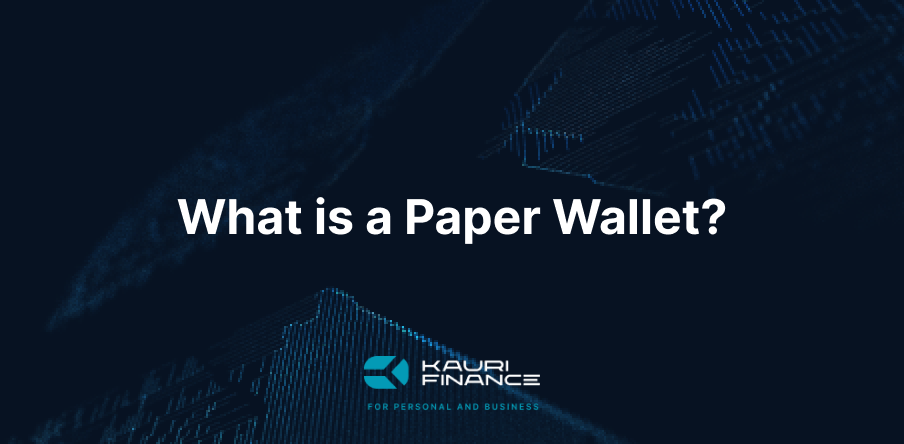
What Is a Paper Wallet? A Comprehensive Guide to Offline Crypto Storage
- Understanding Paper Wallets: The Basics
- The Advantages of Using a Paper Wallet
- Creating a Paper Wallet: Step-by-Step Guide
- Best Practices for Using and Storing Paper Wallets
- Comparing Paper Wallets to Other Storage Methods
- Potential Risks and Limitations of Paper Wallets
- Frequently Asked Questions About Paper Wallets
- What is the difference between a paper wallet and a hardware wallet?
- Can I store multiple cryptocurrencies on a single paper wallet?
- How do I transfer funds from a paper wallet to an exchange or hot wallet?
- Are paper wallets suitable for long-term storage of large amounts of cryptocurrency?
- What should I do if I lose my paper wallet?
- Can paper wallets be hacked?

As we dive deeper into the world of paper wallets, you'll discover how this simple yet powerful tool can revolutionize the way you secure your digital assets.
Understanding Paper Wallets: The Basics
Paper wallets represent a unique blend of analog security and digital assets in the cryptocurrency world. These physical documents contain your public and private keys, printed in both text and QR code formats, serving as offline "cold storage" for your crypto.
-
Composition: Includes public address for receiving funds and private key for spending
-
Generation: Created using specialized, security-focused software
-
Functionality: Offline vault for long-term storage of significant holdings
-
Security: Sidesteps vulnerabilities associated with internet-connected devices
-
Customization: Can incorporate tamper-evident features or lamination for durability
Now that we understand the basics, let's explore the compelling advantages that make paper wallets a popular choice among cryptocurrency enthusiasts.
The Advantages of Using a Paper Wallet
Paper wallets offer a fortress-like approach to cryptocurrency security, blending digital assets with tangible safeguarding. This unique storage method presents several compelling advantages:
-
Impenetrable offline protection: Neutralizes remote hacking threats
-
Customizable security: Tamper-evident seals enhance physical durability
-
Software vulnerability immunity: Sidesteps compromised digital wallets
-
Complete ownership control: Eliminates third-party custodians
-
Cost-effective long-term storage: Ideal for hodling without recurring fees
-
Simplicity and accessibility: Easy to create and use for beginners
With these advantages in mind, you might be wondering how to create your own paper wallet. Let's walk through the process step-by-step.
Creating a Paper Wallet: Step-by-Step Guide
Crafting a paper wallet demands meticulous security. Download a reputable wallet generator like BitAddress onto an air-gapped computer running a live Linux distribution. Disconnect from the internet, clear your RAM, and generate a new wallet address by moving your mouse randomly to increase entropy. Verify the keys, then print them on high-quality acid-free paper using a printer without internal storage.
For added protection, consider a tamper-evident holographic seal. Store your wallet in a waterproof, fireproof safe or bank deposit box. Create multiple copies and store them separately. Remember, once printed, you're responsible for safeguarding your keys. Treat your paper wallet like cash—once lost, it's irretrievable.
Now that you know how to create a paper wallet, it's crucial to understand the best practices for using and storing them to maximize their security benefits.
Best Practices for Using and Storing Paper Wallets
Securing a paper wallet requires meticulous attention to both digital and physical safeguards. Generate your wallet on an air-gapped device, using high-quality, acid-free paper and archive-grade ink. Consider fireproof storage or lamination for added protection.
-
Implement Shamir's Secret Sharing for distributed key security
-
Use multi-signature setups for enhanced protection
-
Verify wallet integrity regularly without exposing private keys
-
Employ tamper-evident packaging to detect physical breaches
-
Create a secure recovery plan with encrypted digital backups
Treat your paper wallet like a vault of precious metals, minimizing digital exposure to maximize its offline security benefits.
As we've seen, paper wallets offer unique security benefits, but how do they stack up against other storage methods? Let's compare them to find out.
Comparing Paper Wallets to Other Storage Methods
In the realm of cryptocurrency storage, paper wallets stand out as a unique analog solution. Let's compare them to other popular methods:
|
Method |
Security |
Accessibility |
Complexity |
|
Paper Wallets |
High (Offline) |
Low |
Moderate |
|
Hardware Wallets |
Very High |
Medium |
Low |
|
Software Wallets |
Medium |
High |
Low |
|
Exchange Wallets |
Low-Medium |
Very High |
Very Low |
While paper wallets excel in offline security, they lack the ease of access offered by software wallets or the advanced features of hardware wallets. However, their simplicity and cost-effectiveness appeal to long-term hodlers seeking a tangible connection to their digital assets.
While paper wallets have their strengths, it's important to be aware of their potential drawbacks. Let's explore some of the risks and limitations you should consider.
Potential Risks and Limitations of Paper Wallets
While paper wallets offer robust offline security, they're not impervious to risks. Physical damage, human error in key generation, and lack of built-in redundancy pose significant threats. Technological obsolescence may complicate future transactions, and the irreversible nature of crypto transfers amplifies mistake consequences. Despite their simplicity, paper wallets demand meticulous handling and deep crypto knowledge to mitigate inherent risks.
Now that we've covered the essentials of paper wallets, let's address some common questions that often arise when considering this storage method.
Frequently Asked Questions About Paper Wallets
What is the difference between a paper wallet and a hardware wallet?
Paper wallets are physical printouts of cryptographic keys, offering offline security but limited functionality. Hardware wallets, conversely, are dedicated devices with built-in screens and buttons, providing enhanced security features, multi-currency support, and easier transaction capabilities while maintaining offline protection against cyber threats. Both have unique advantages.
Can I store multiple cryptocurrencies on a single paper wallet?
Paper wallets typically store one cryptocurrency. However, innovative solutions enable multi-asset storage. Some generators create separate key pairs for different coins, while others use hierarchical deterministic wallets. Exercise caution when exploring these options.
Transferring funds from a paper wallet requires careful handling. Let's explore the process step-by-step.
How do I transfer funds from a paper wallet to an exchange or hot wallet?
To transfer funds from a paper wallet, import the private key into a compatible software wallet. Verify the receiving address, initiate a small test transaction, then move the full amount. Always confirm the transaction on the blockchain explorer before proceeding.
Are paper wallets suitable for long-term storage of large amounts of cryptocurrency?
Paper wallets offer robust offline security for long-term crypto storage, ideal for substantial holdings. However, they demand meticulous handling and secure physical storage. For significant investments, consider combining paper wallets with other security measures to maximize protection against potential risks.
What should I do if I lose my paper wallet?
Losing a paper wallet? Act fast. Transfer funds from backups to a new address. Without backups, accept the loss and learn. For future wallets, use multi-signature setups or Shamir's Secret Sharing to mitigate single-point-of-failure risks. Let's explore paper wallet security next.
Can paper wallets be hacked?
Paper wallets, while offline, aren't impervious to risks. Physical theft, social engineering, and flawed generation processes can compromise security. Malicious printers or compromised computers during creation may expose keys. Innovative attackers might exploit QR code vulnerabilities or use advanced imaging techniques to breach seemingly secure wallets.
